About French Pastries
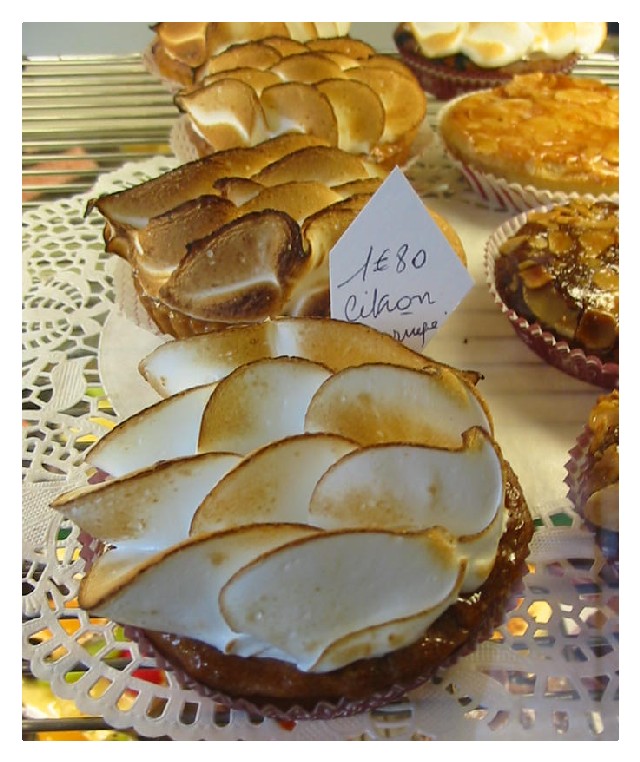 The other day, while waiting in line for the bread, I perused the pretty tartes my boulanger is offering at the moment. Our baker seems to have mastered the art of instilling teatime intimacy and invitation to companionship into his round fruit pies. Just looking at one brings out the idea of camaraderie in my mind. He is able sum up simple pleasures with an easy sweep. He has devoted his life to this and he does us a great service.
The other day, while waiting in line for the bread, I perused the pretty tartes my boulanger is offering at the moment. Our baker seems to have mastered the art of instilling teatime intimacy and invitation to companionship into his round fruit pies. Just looking at one brings out the idea of camaraderie in my mind. He is able sum up simple pleasures with an easy sweep. He has devoted his life to this and he does us a great service.Today in France there are many degrees of pastry ranging from prêt a manger to haute patisserie. Once we step out into the world and away from our kitchen table there are lots of choices. At a boulangerie, depending on how the baker has positioned his craft, his or her equipment, and professional mentors or schooling along the way, the offerings vary.
The Boulanger-Pâtissier
A variety of chains train their franchised bakers to turn out a consistent line products created on a montage model of the ideal traditional boulangerie - conceived by the dream marketing team at company headquarters. When you go to Banette for example you can expect a certain consistency in the basic pastries lined up next to the bread at this chain, and for the most part, find the same ones over and over. Don’t turn up your nose at these treats, they can be very good. But they can differ from what is offered elsewhere.
The Artisan Boulanger-Pâtissier
Sometimes a baker has a wood fired oven that gives a certain rustic quality to his or her breads, so the pastries are the simple heat applied variety, transforming the fruit of the workman’s labor just so. These sweets are great for spicing up a table for a family that doesn’t have time to make a tarte, flan, or clafoutis themselves, and pastries from these bakeries are very popular. We often catch up on the neighborhood news while waiting in line for these pastries.
 Tartes and pastries at the St, Antoine Market in Lyon.
Tartes and pastries at the St, Antoine Market in Lyon.An artisan baker finds his or her rhythm in response to their need for creative expression and the neighborhood demands. Some may have a certain knack for marzipan or fondant, and many of course offer savory puff pastry and quiche to round out their stock. The range of patisseries available varies according to geographical area in France, and the season. If an artisan boulanger/patissiere is situated in a heavily trafficked tourist area, he or she may choose to position local specialties as well.
 A regional specialty from an artisan baker in Brittany
A regional specialty from an artisan baker in Brittany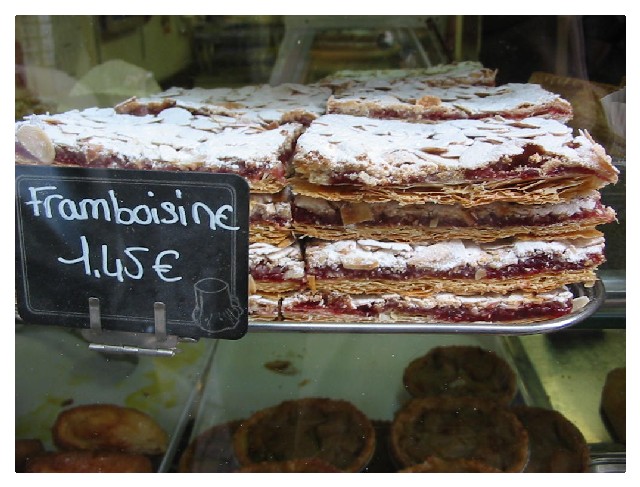 A house specialty from the same baker in St. Malo.
A house specialty from the same baker in St. Malo. Typical pastries at an artisan boulangerie-patisserie in St. Malo, Brittany
Typical pastries at an artisan boulangerie-patisserie in St. Malo, Brittany Typical pastries at an artisan boulangerie-patisserie in Toulon, Provence.
Typical pastries at an artisan boulangerie-patisserie in Toulon, Provence.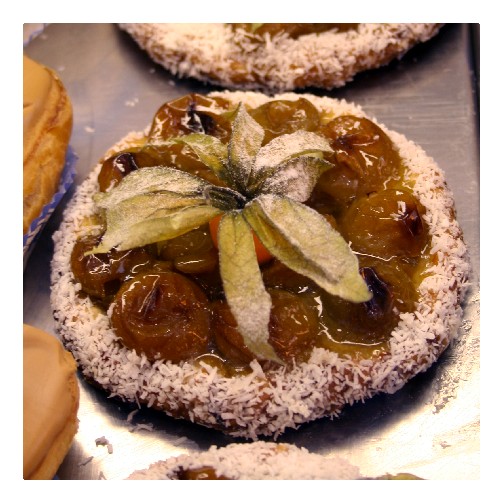 A house specialty, Toulon, Provence.
A house specialty, Toulon, Provence.The Chocolatier–Pâtissier
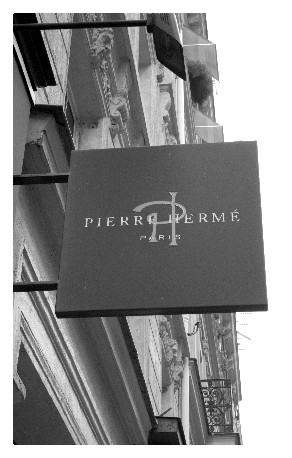
If you want to get fancy, you can go to the chocolatier – pâtissiers, trained pastry and chocolate master chefs, the ones who don’t occupy themselves with the daily leavening of the bread and would scoff at the inconsistency of a wood fired oven for their creations. At this level, chocolate and pastry are intertwined. These are pastry houses whose operations might be destinations in themselves – pastry and chocolate are their product, and their expertise is what brings in the masses.
 Pastries in the front window at Bernachon, Lyon
Pastries in the front window at Bernachon, LyonThe work of the chocolatier – pâtissier includes a dizzying array of pastries constructed with an eye for perfection in addition to shelves of chocolates to choose from. Reserved for special occasions like birthdays, holidays, and parties where a special dessert is in order, they’re haute gamme pastries. You might find playful symbolism, sculptural creation, or studies of texture and material in their offerings. They’ll render homage to the classics in addition to their original creations, but always better somehow, or with their own special twist, ingredient, or technique. Often the chocolatier – pâtissier has a little teahouse on the side, where mini-versions of house creations can be enjoyed as a decadent snack with a friend. Although there are a few big names that have become tourist destinations, there are a lot of smaller independently run chocolatier – pâtissiers that continue to offer not only great pastry and chocolates, but beautiful and interesting surroundings to enjoy them in.
The World Pastry Cup
Once every two years here in Lyon France, the World Pastry Cup takes place. It is a world-class competition where an international panel of judges decides who will be the reining champion of international chocolate and patisserie.
 French pastry and chocolate are clearly firmly planted in the concept of perfection in this competition; to what degree it is French or that it transcends international boundaries is hotly debated every time from the makeup of the panels of judges and their influences, to standards in each area of competition.
French pastry and chocolate are clearly firmly planted in the concept of perfection in this competition; to what degree it is French or that it transcends international boundaries is hotly debated every time from the makeup of the panels of judges and their influences, to standards in each area of competition.
National teams train for months or even years for a chance at the ultimate challenge to compete and create masterpieces never before contemplated but at the same time resting firmly in the age old techniques in sugar sculpture, dessert plates, and chocolate. The stress leading up to and culminating in this event is very high. I attended the 2005 event with the man who was to be the president of the British team and a member of the judging panel. Unfortunately, due to one team member backing out apparently due to jittery nerves at the last minute, the team was not able to participate.
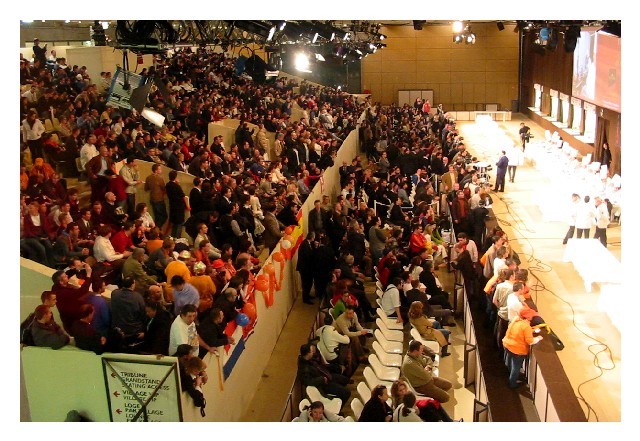
 The masterpieces turned out by these perfectionists are passionate testaments to pastry and chocolate as the highest level of art, and there is so much more at play in this competition than how things look and taste. Even the redolent smell of chocolate, which usually has soothing effect, was not going to calm the wire tight nervous energy permeating that competition. It was glamorous and glorious. People paid for seats to witness the pastry masters at work in their identical kitchens. Pastry groupies were in the stands with their faces painted, waving flags, cheering on their teams.
The masterpieces turned out by these perfectionists are passionate testaments to pastry and chocolate as the highest level of art, and there is so much more at play in this competition than how things look and taste. Even the redolent smell of chocolate, which usually has soothing effect, was not going to calm the wire tight nervous energy permeating that competition. It was glamorous and glorious. People paid for seats to witness the pastry masters at work in their identical kitchens. Pastry groupies were in the stands with their faces painted, waving flags, cheering on their teams. 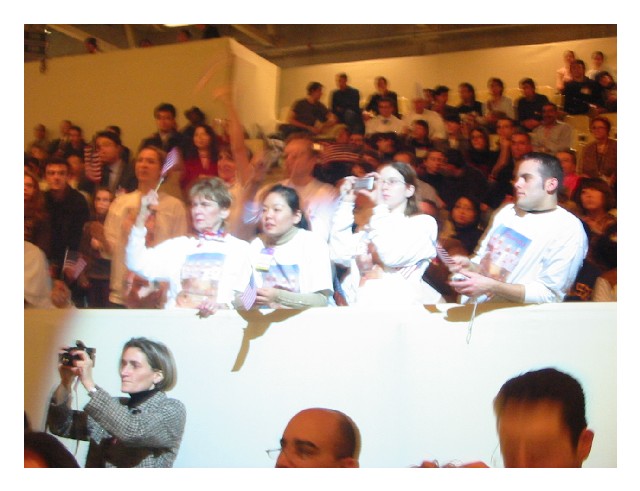 Are you a pastry groupie?
Are you a pastry groupie?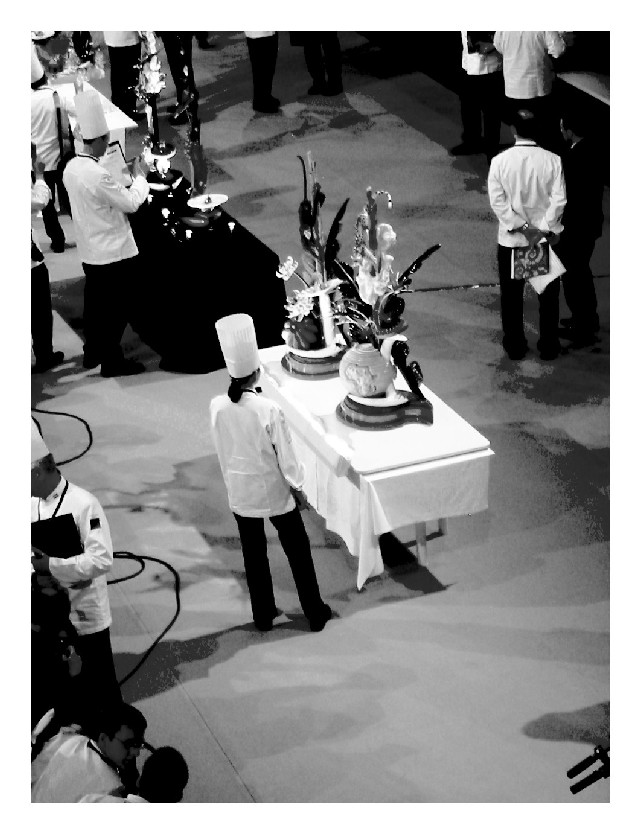
I went back home after a long day and compiled my notes feeling a bit overwhelmed. However when I received the invitation for the 2007 event this week, I felt that spark of excitment.
So now, in my little kitchen looking out on the cloudy afternoon, I make a pot of tea to share with a friend and smell the delicious home made tartelettes inspired by my rustic boulanger of the people.

Tarte au poire
Ingredients:
1 batch of pâte brisé
1-2 pears
2 egg yolks
50 grams or 3T. sugar
100 grams or about 1/2 cup of fromage frais en faiselle

*about the pears – they type of pear you want to choose is the sweetest one available. Right now is pear season here in France, and the pears I choose are the Comice pears. They make for excellent eating plain but are simply delicious in these tartes.
*about the fromage frais en faiselle - The easiest replacement is large curd cottage cheese, preferably a brand that contains lots of whey. If your available cottage cheese has been relieved by machine extrusion of most of its whey, add a tablespoon or two of milk to the cheese before measuring it. If you are in Italy, use ricotta. If you are feeling particularly ambitious and want to really get authentic, get some rennet and make your own fromage frais.
- Prepare one batch of basic pâte brisé.
- When your dough is ready to roll out, peel the pears, cut them in half, remove the core, and with the flat side down, slice the pears into 1/8 inch or 1/2 cm slices, maintaining the pear shape and not mixing up the pieces.

- Heat the oven to 400F or 210C.
- Blend the fromage frais or cottage cheese, sugar, and egg yolks until a completely smooth liquid mixture. If you are using cottage cheese, and it seems more like a paste than a liquid, add more milk.

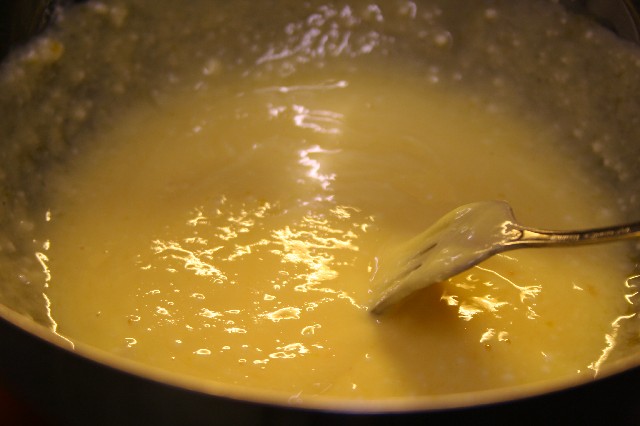
- Cut your pâte brisé into four pieces and quickly roll them into ball shapes. Roll out the pastry dough until the circles are about 2 inches or 4 cms larger than the tarte rings. Place the empty tarte rings on an ungreased or parchment lined cookie sheet. Either will do but the latter is easier to clean, since sometimes you get a drizzle or two from the pears bubbling up, depending on how juicy they are. Lay the pastry dough into them the rings, easing it to the sides of the mould and up to the top. Remove any excess dough that extends beyond the top of the rings – you can use it to patch along the edges if you need to.
- Spoon 1-2 teaspoons of the custard mix into the bottom of the unbaked tarte shells. Take 1/4 of the sliced pear per ring and splay the pieces like fallen dominoes into the crust. Pour the rest of the custard around the pears nearly to the top, and place the little pies in the oven to bake.
- Bake for 20 minutes at 200C or 400F. Let cool and remove from the moulds. Voila.

Note: If you have quince jelly on hand, this is an excellent opportunity to add the splendor of Autumn to the flavor of this tarte. Add a teaspoon or two to the custard mix. Remember, you are not obligated to eat enormous portions of the pastries you lovingly prepare for others, although the love that you do express in preparing them will always return in other ways.
Labels: Bernachon, Fall 06, French Pastries and Desserts
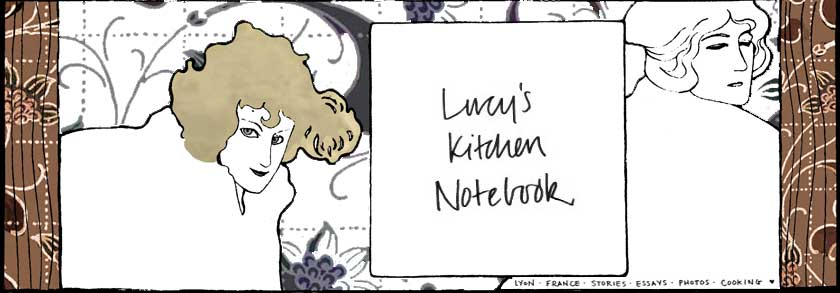


























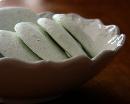








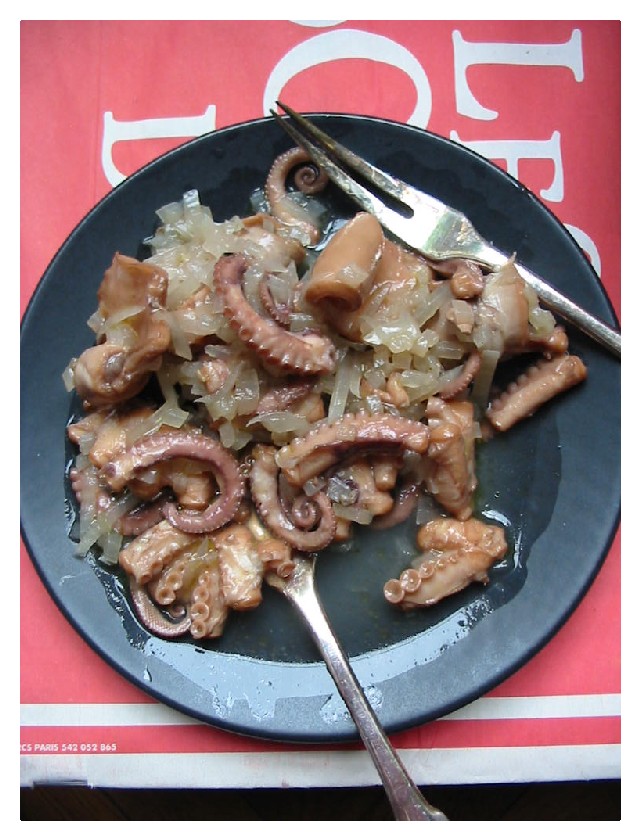


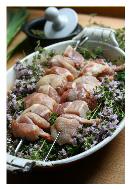













18 Comments:
You must've eaten a lot of pastries to write this post! If I lived near Bernachon, I'd be considered a stalker, going in every day.
But I do have a question; What's with all those bright pink nuggets of pralines on everything in Lyon? They kinda scare me...
Theya re a bit scary, David, because I wonder what they used during the years that bright red food coloring (#3) was considered a health hazard. This is a traditional Lyonnais way of coloring roasted and caramelized almonds and nuts. Sometimes when you really get a cheapskate of a baker, you'll order a praline tarte and only get red colored sugar witha few nut pieces in it drooled over a sugar cookie. I know a place that does them just right, though, and the next time you come to Lyon I will show you.
Oh man...I loved going to the boulangeries all over France...we have a new bakery opening up the street, I hope it's good :)
Waou, it's really gorgeous, all this photos
You have once again, produced an incredible blog! I am so envious you have all of this so close at hand.
Thank you for the lovely photos!
Oh they all look so pretty and so delicious. I love reading your blog.
@ Great jo, great photo's and great recipe!!!
I love your blog!!
Great Job!! Sorry... :-)
thanks for sharing such great photos and write up with us!!!!
Franchini, congratulations on entering the world of home baked pastry! This particular recipe is not as sweet as most, and brings out the flavor of the fruit over everything else. It's perfect for right now when we have the nice sweet comice pears to enjoy. Thank you for your comments.
I attened the cooking competition last year and saw all the amazing pastry creations throughout the exhibition hall, my husband had to point out to me that they were made from suagr and chocolate.
Sorry I've been lax in my reply but I'd love to go to the market with you some day. I bet I'd learn a lot!
A feast for the eyes and le ventre! Thanks for a lovely balade amongst pastry delicacies.
This is the first day I have been able to see all the photos — magnificent.
I want to try Taret Au Poire — but I may have to call in sick to find a day where I can do it without interruption.
Hi Lucy, this article is so informative for the wannebe-patissier i am.
And the pastries look so tempting!!!
fanny
How mouthwatering! I've often tried to recreate the lovely fruit tarts I ate in France but I never succeeded with the pastry. Even when following a recipe from Paul Bocuse himself - well, it wasn't a disaster but it wasn't a success either...
BTW, I just discovered your blog and absolutely love your photos! Will work my way through your archive...;-)
Delicious looking pastries. Thanks for posting!
Lucy,
I just wanted to stop in and say that reading your blog is delightful and so inspiring! You are a wonderful resource for the American lady dabbling in French cooking - your measurement translation is so helpful for at-a-glance cooking, and your substitutions for those who don't have all of France's lovely markets and farms and what-all at their feet are so thoughtful. You are a dear and I love reading your thoughts - and stealing your recipes! Love and well wishes from the US -
-Cattie
Lucy, this is wonderful, wonderful! You are an inspiration. I always avoided making pastry thinking I would muck it up, but you convinced me and I can do it.
Thank you. Nancy
Post a Comment
<< Home